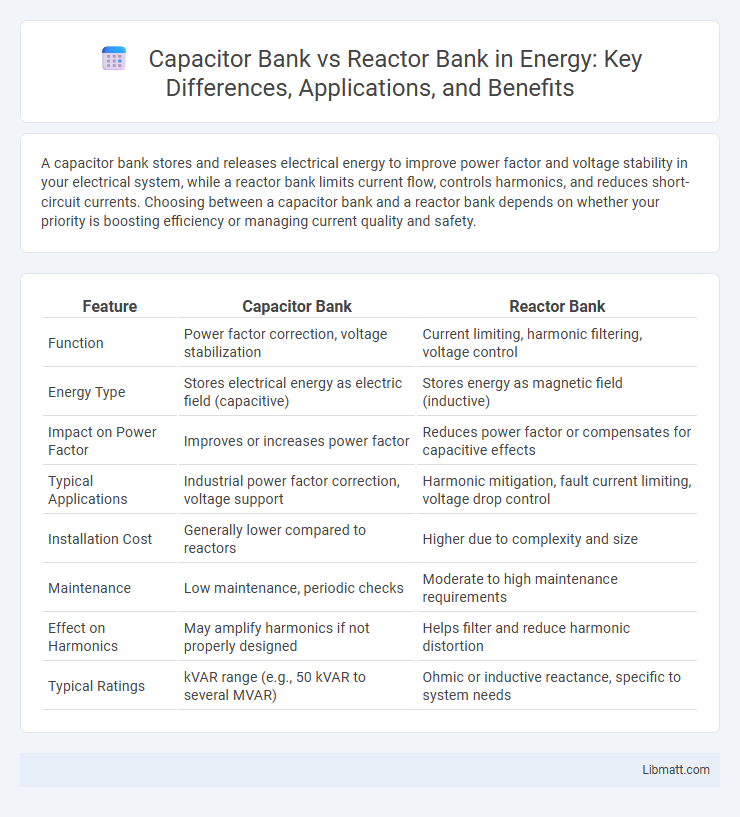A capacitor bank stores and releases electrical energy to improve power factor and voltage stability in your electrical system, while a reactor bank limits current flow, controls harmonics, and reduces short-circuit currents. Choosing between a capacitor bank and a reactor bank depends on whether your priority is boosting efficiency or managing current quality and safety.
Table of Comparison
| Feature | Capacitor Bank | Reactor Bank |
|---|---|---|
| Function | Power factor correction, voltage stabilization | Current limiting, harmonic filtering, voltage control |
| Energy Type | Stores electrical energy as electric field (capacitive) | Stores energy as magnetic field (inductive) |
| Impact on Power Factor | Improves or increases power factor | Reduces power factor or compensates for capacitive effects |
| Typical Applications | Industrial power factor correction, voltage support | Harmonic mitigation, fault current limiting, voltage drop control |
| Installation Cost | Generally lower compared to reactors | Higher due to complexity and size |
| Maintenance | Low maintenance, periodic checks | Moderate to high maintenance requirements |
| Effect on Harmonics | May amplify harmonics if not properly designed | Helps filter and reduce harmonic distortion |
| Typical Ratings | kVAR range (e.g., 50 kVAR to several MVAR) | Ohmic or inductive reactance, specific to system needs |
Introduction to Capacitor and Reactor Banks
Capacitor banks store electrical energy and release it to improve power factor and voltage stability in electrical systems, while reactor banks absorb reactive power to limit current and reduce harmonics. Your electrical network benefits from capacitor banks by enhancing efficiency and reducing losses, whereas reactor banks protect equipment by controlling excessive currents and mitigating disturbances. Both components are essential in managing reactive power and maintaining optimal system performance.
Basic Functions of Capacitor Banks
Capacitor banks primarily serve to improve power factor and voltage stability in electrical power systems by providing reactive power compensation. They help reduce energy losses, enhance system efficiency, and support voltage regulation under varying load conditions. Capacitor banks are often installed in substations and industrial facilities to optimize electrical performance and reduce costs associated with poor power factor penalties.
Key Roles of Reactor Banks
Reactor banks primarily function to absorb reactive power in electrical power systems, improving voltage stability and reducing overvoltages during light load conditions. They play a crucial role in controlling harmonics and limiting fault currents, thus enhancing overall power quality and system protection. Unlike capacitor banks that inject reactive power, reactor banks mitigate excessive voltage rise and maintain system balance, especially in high-voltage transmission networks.
Differences in Power Factor Correction
Capacitor banks improve power factor by supplying leading reactive power, thereby reducing the lag caused by inductive loads and increasing overall system efficiency. Reactor banks, on the other hand, absorb reactive power to lower the leading power factor or control harmonic distortion in the electrical network. While capacitor banks primarily enhance lagging power factor correction, reactor banks are utilized to fine-tune power quality and prevent overcorrection or penalties from utilities.
Impact on System Voltage Stability
Capacitor banks enhance system voltage stability by injecting reactive power, which supports voltage levels during peak load conditions and reduces voltage fluctuations. Reactor banks improve voltage stability by absorbing excess reactive power, preventing overvoltage situations and maintaining voltage within safe limits. Proper integration of both capacitor and reactor banks optimizes system voltage stability by balancing reactive power in electrical networks.
Harmonic Mitigation: Capacitor vs Reactor Banks
Capacitor banks increase voltage levels and can amplify harmonics, potentially causing resonance and increased distortion in power systems. Reactor banks, also known as harmonic filters, effectively reduce harmonic currents by providing inductive reactance that dampens these frequencies and mitigates harmonic distortion. Selecting reactor banks over capacitor banks is critical for managing harmonic mitigation in industrial electrical networks with nonlinear loads.
Installation and Maintenance Considerations
Capacitor banks require careful installation with attention to insulation and thermal management due to their voltage rating and potential for harmonic distortion, while reactor banks demand robust cooling systems and precise sizing to handle inductive loads and prevent overheating. Maintenance of capacitor banks involves regular inspection for capacitor element health and cleaning to avoid dielectric breakdown, contrasting with reactor banks that require monitoring of winding resistance and verification of cooling system functionality to ensure reliable performance. Both systems benefit from protective devices like surge arresters, but reactor banks typically necessitate more specialized maintenance due to their complex electromagnetic properties.
Cost Comparison and Economic Aspects
Capacitor banks typically offer lower initial costs and higher energy savings by improving power factor and reducing reactive power charges, making them economically advantageous for facilities with consistent inductive loads. Reactor banks, while generally more expensive to install due to their complexity and size, help control overvoltage and limit short-circuit currents, which can reduce equipment damage costs and improve system reliability in the long term. The overall economic decision depends on the specific power quality needs, load characteristics, and utility tariff structures influencing operational expenses and return on investment.
Typical Applications in Power Systems
Capacitor banks are typically applied in power systems to improve power factor, voltage regulation, and reduce losses by supplying reactive power locally, which is crucial in industrial plants and distribution networks. Reactor banks serve to limit short-circuit currents, control voltage by absorbing reactive power, and filter harmonic distortions, commonly used in transmission systems and substations. Your choice between capacitor and reactor banks depends on whether the priority is to provide reactive power support or to manage system stability and protection.
Choosing Between Capacitor and Reactor Banks
Choosing between capacitor and reactor banks depends on your power system's reactive power needs and voltage control requirements. Capacitor banks supply reactive power, improving voltage profiles and reducing power losses, while reactor banks absorb reactive power, preventing overvoltage during low load conditions. Your decision should consider load characteristics, system stability, and desired power factor correction to optimize energy efficiency and equipment lifespan.
Capacitor bank vs Reactor bank Infographic

 libmatt.com
libmatt.com